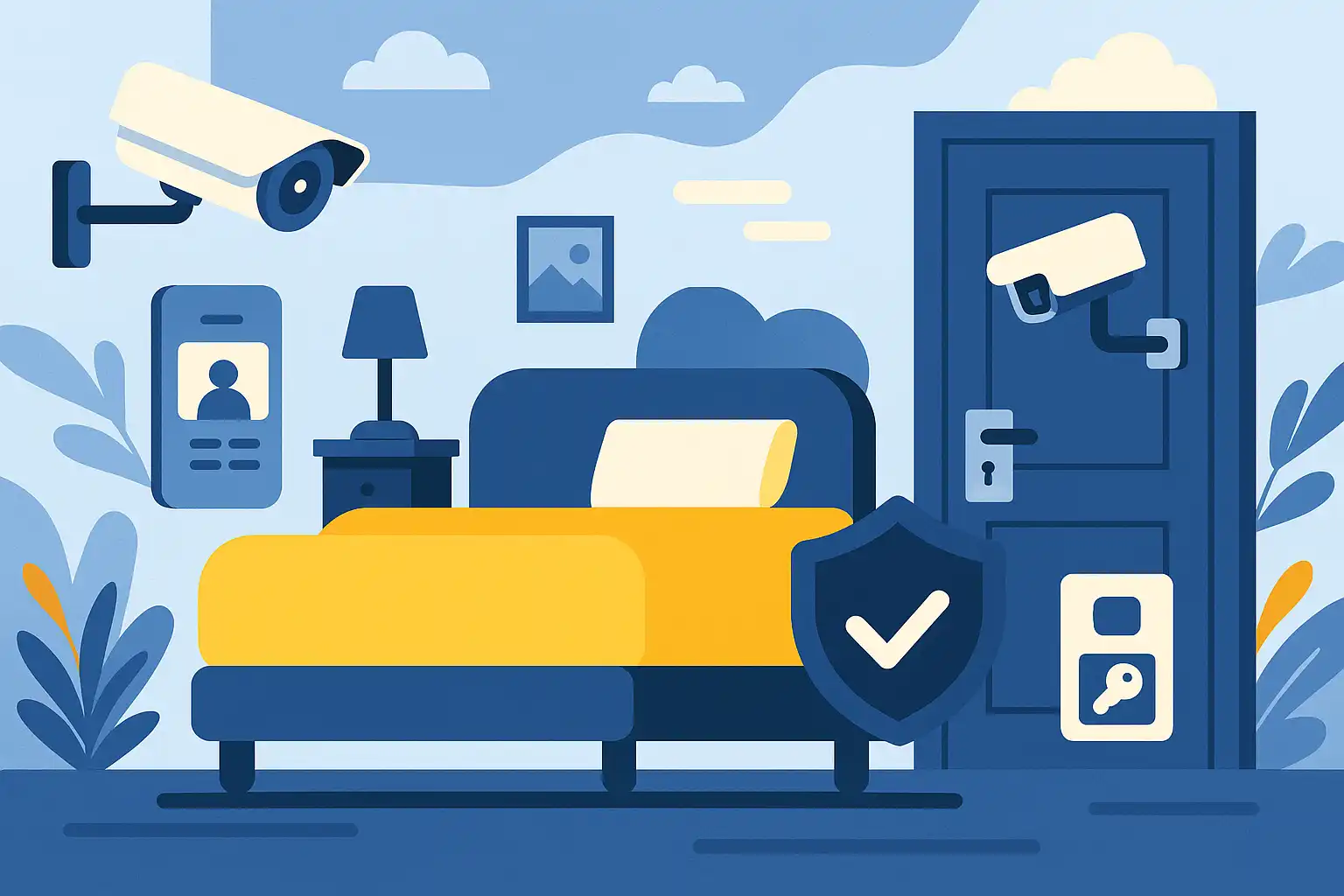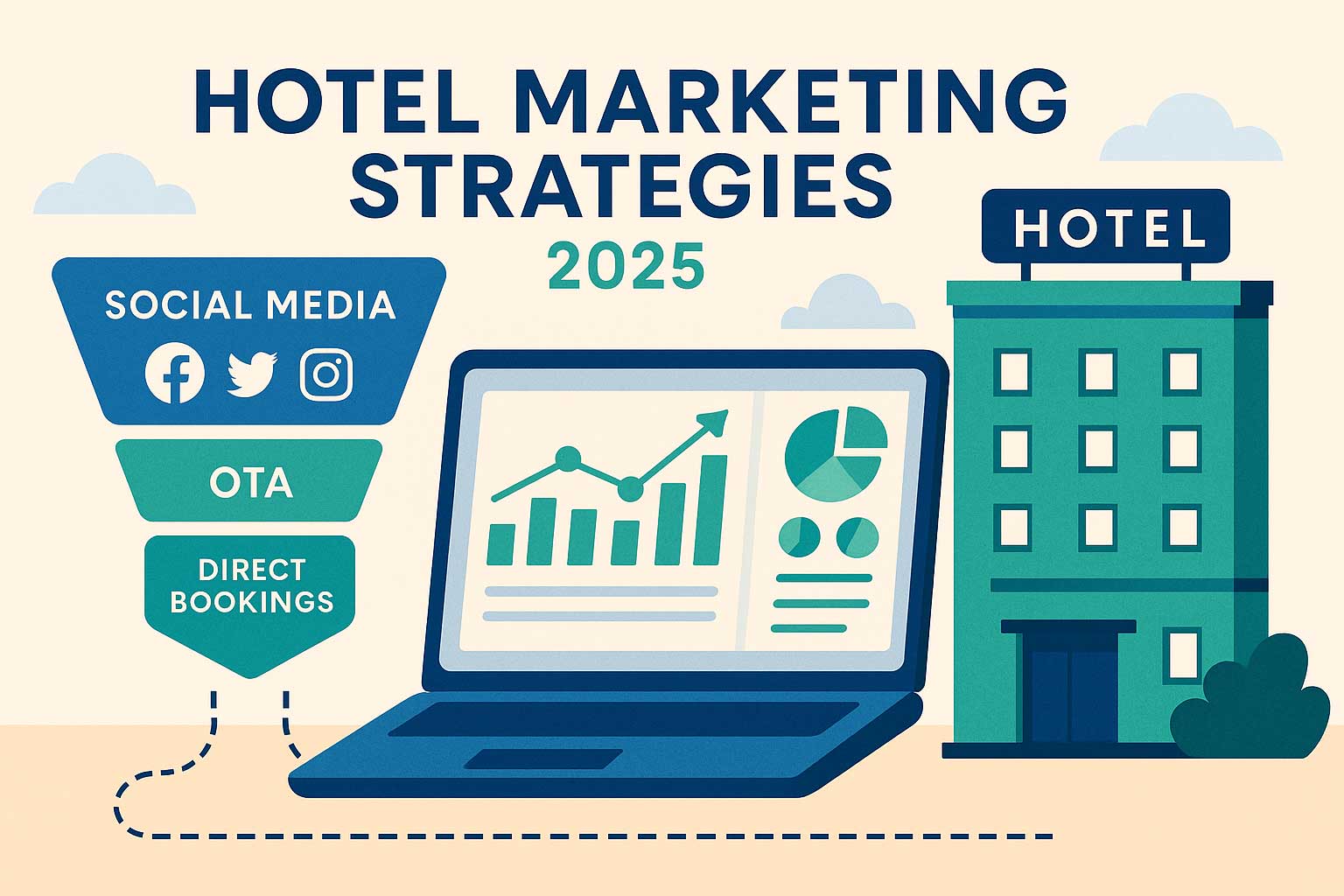Hotel Net Operating Profit (NOP): Maximize Financial Performance
Aug 31, 2025
 Mika Takahashi
Mika TakahashiPopular Categories
Hotel Technology & InnovationHotel Operations OptimizationDigital MarketingIndustry TrendsRevenue ManagementHospitality Industry
Popular Categories
Trending Post

Hotel Walk Letter Template: Professional Guest Communication

Online Travel Agents: What They Are and How They Work

Hotel Security Systems: Modern Protection Solutions

Hotel Advertising: Complete Guide to Boost Bookings and Revenue

25 Hotel Marketing Strategy Ideas for 2025: Complete Guide

AI Reservation Agent: Revolutionizing Hotel Booking and Guest Experience

PMS Communication: Streamlining Property Management Through Effective Guest Messaging
Table of contents
Hotel net operating profit has become the definitive measure of property performance in today’s competitive hospitality landscape. While total revenue and guest satisfaction metrics capture headlines, savvy hotel investors and operators know that net operating profit (NOP) reveals the true financial health of their properties.
This comprehensive guide explores everything you need to know about hotel net operating profit, from basic calculations to advanced optimization strategies. Whether you’re evaluating a potential investment, benchmarking current performance, or developing strategies to boost revenue while controlling costs, understanding NOP is essential for making informed decisions in the hotel industry.
The COVID-19 pandemic fundamentally changed how hotels approach profitability. Properties that survived and thrived were those that mastered the balance between revenue management and operational efficiency. As we navigate the post-pandemic recovery, hotel net operating profit has emerged as the key indicator that separates successful properties from struggling ones.
What is Hotel Net Operating Profit (NOP)?
Hotel net operating profit represents the money left over after subtracting all operating expenses from total revenue, but before accounting for debt service, taxes, depreciation, and capital expenditures. This metric provides a clear picture of how effectively a hotel generates profit from its core operations.
In the hotel industry, net operating profit is often used interchangeably with net operating income (NOI). Both terms describe the same fundamental calculation: total revenue minus operating expenses equals net operating profit. This standardization allows investors and operators to compare properties across different markets, brands, and ownership structures.
The key distinction between hotel net operating profit and hotel gross operating profit (GOP) lies in what expenses are included. While GOP excludes certain overhead costs and administrative expenses, NOP includes all operating costs necessary to run the property. This makes NOP a more comprehensive measure of operational efficiency.

Understanding why hotel net operating profit excludes certain items is crucial for proper analysis. Interest payments on loans, property taxes, and depreciation reflect financing and ownership decisions rather than operational performance. By excluding these elements, NOP allows for fair comparisons between properties regardless of their capital structure or ownership model.
Since the 2020 pandemic, hotel net operating profit has gained even greater significance as lenders, investors, and management companies focus on sustainable cash flow generation. Properties with strong NOP margins proved more resilient during market downturns and recovered faster as demand returned.
How to Calculate Hotel Net Operating Profit
The nop formula is straightforward: Total Revenue - Operating Expenses = Net Operating Profit. However, understanding what components to include in each category ensures accurate calculations and meaningful comparisons.
Revenue Components
Hotel revenue encompasses all income generated from property operations. Room sales typically represent the largest revenue source, but successful properties maximize income from multiple streams:
- Room Revenue: Standard room bookings, suites, and premium accommodations
- Food & Beverage: Restaurant sales, room service, banquets, and catering
- Meeting and Event Space: Conference rooms, ballrooms, and event coordination
- Ancillary Revenue: Spa services, parking fees, resort fees, Wi-Fi charges, and other services
- Other Income: Laundry services, business center usage, and retail operations
Diversifying revenue streams helps stabilize hotel profit margins during periods of fluctuating room demand. Properties with strong F&B operations or meeting facilities often maintain better profitability during low-occupancy periods.
Operating Expense Categories
Operating costs include all expenses necessary for day-to-day hotel operations. These typically fall into several major categories:
Payroll and Benefits: Labor represents the largest single operating expense for most hotels, including:
- Front desk and guest services staff
- Housekeeping and maintenance teams
- Food & beverage personnel
- Management and administrative staff
- Employee benefits and payroll taxes
Property Operations: Essential operational expenses include:
- Utilities (electricity, gas, water, waste management)
- Property maintenance and repairs
- Guest supplies and amenities
- Marketing and advertising costs
- Insurance premiums
- Professional services (legal, accounting, consulting)
Step-by-Step Calculation Example
Let’s calculate nop net operating profit using a practical example. Consider a mid-scale hotel with the following annual figures:
Total Revenue: $2,400,000
- Room revenue: $1,800,000
- Food & beverage: $480,000
- Meeting space: $72,000
- Ancillary revenue: $48,000
Operating Expenses: $1,680,000
- Payroll and benefits: $960,000
- Utilities: $168,000
- Marketing: $96,000
- Maintenance: $120,000
- Supplies: $144,000
- Insurance: $72,000
- Other operating costs: $120,000
Net Operating Profit Calculation: $2,400,000 (Total Revenue) - $1,680,000 (Operating Expenses) = $720,000 (Net Operating Profit)
NOP Margin Calculation: ($720,000 ÷ $2,400,000) × 100 = 30% NOP margin
This 30% net profit margin falls within the typical range for a well-managed mid-scale property, demonstrating solid operational efficiency without compromising guest experience.
Why Hotel Net Operating Profit Matters
Hotel net operating profit serves multiple critical functions in hospitality finance and investment analysis. Understanding these applications helps explain why hotel NOP has become the industry’s preferred performance metric.
Hotel Valuation and Investment Analysis
Investors use hotel net operating profit as the foundation for property valuation through the income capitalization approach. By dividing stabilized hotel NOP by an appropriate capitalization rate, investors can estimate a property’s market value. For example, a hotel generating $720,000 in annual NOP with a 7% cap rate would be valued at approximately $10.3 million.
The reliability of this valuation method depends on accurate NOP calculations and appropriate cap rate selection. Market demand, property condition, location quality, and competitive dynamics all influence the cap rate investors apply to a given property’s net operating income.
Lender Requirements and Debt Service
Banks and other lenders closely examine hotel net operating profit when evaluating loan applications and ongoing compliance. The debt service coverage ratio (DSCR) compares a property’s NOP to its annual debt payments. Most lenders require a minimum DSCR of 1.2 to 1.25, meaning the property must generate at least $1.20 in NOP for every $1.00 of debt service.
Properties with strong and stable hotel NOP performance can typically secure better financing terms, including lower interest rates and higher loan-to-value ratios. Conversely, declining NOP trends may trigger loan covenant violations or require additional collateral.
Performance Benchmarking and Management Evaluation
Hotel operators use net operating profit for internal benchmarking and performance evaluation. Comparing a property’s NOP margin to similar hotels in the market segment reveals operational strengths and improvement opportunities. Management companies often structure incentive fees based on NOP performance, aligning management interests with ownership objectives.

The standardized nature of NOP calculations enables meaningful comparisons across different properties, even when they operate under different brands or management structures. This comparability makes NOP an essential tool for portfolio management and strategic planning.
Since 2022, market shifts have intensified focus on operational efficiency as labor costs have increased and consumer behavior has evolved. Properties that maintained strong NOP margins during this transition period demonstrated superior revenue management and expense control capabilities.
Hotel NOP Benchmarks and Industry Standards
Understanding typical hotel profit margins by segment helps operators set realistic targets and identify performance gaps. However, these benchmarks vary significantly based on property type, location, and market conditions.
NOP Margins by Hotel Segment
Different hotel segments achieve varying profit margins based on their service levels, cost structures, and pricing strategies:
Luxury Hotels (25-35% NOP margin) Luxury hotels typically achieve lower NOP margins due to higher labor costs, extensive amenities, and premium service standards. However, they command higher room rates and generate substantial ancillary revenue from spas, fine dining, and premium services.
Full-Service Hotels (15-25% NOP margin) Full-service properties balance moderate room rates with diverse revenue streams from restaurants, meeting spaces, and guest services. Their NOP margins reflect higher operating costs but also greater revenue diversification.
Limited-Service Hotels (35-45% NOP margin) Limited-service hotels achieve the highest NOP margins by focusing on efficient room operations with minimal additional services. Lower labor costs and simplified operations contribute to superior profitability per revenue dollar.
Resort Properties (20-30% NOP margin) Resorts typically fall between full-service and luxury margins, depending on their amenity mix and seasonal demand patterns. Successful resorts maximize ancillary revenue during peak seasons while managing variable costs during slower periods.
Geographic and Market Variations
Location significantly impacts hotel net operating profit potential. Urban markets often provide higher revenue per room but face increased labor costs and operational complexities. Suburban markets may offer lower operating costs but require different marketing strategies to maintain occupancy levels.
Resort destinations experience pronounced seasonal fluctuations that affect annual NOP calculations. Operators in these markets must carefully manage fixed costs during off-peak periods while maximizing profits during high-demand seasons.
Post-Pandemic Recovery Patterns
The hotel industry’s 2023 performance showed significant NOP recovery compared to 2019 pre-pandemic levels, though recovery patterns varied by segment and location. Limited-service hotels recovered fastest, achieving NOP margins equal to or exceeding 2019 levels by early 2023.
Luxury hotels and urban properties faced longer recovery periods due to slower business travel return and changed corporate meeting patterns. However, strong leisure demand and effective cost management enabled many properties to achieve profitable operations even with reduced occupancy levels.
Strategies to Improve Hotel Net Operating Profit
Maximizing hotel net operating profit requires a systematic approach to both revenue enhancement and expense management. The most successful properties focus on sustainable strategies that improve profitability without compromising guest satisfaction or long-term competitiveness.
Revenue Enhancement Tactics
Effective revenue management forms the foundation of NOP optimization. Properties that master dynamic pricing, demand forecasting, and channel management consistently outperform competitors in profitability metrics.
RevPAR Optimization Through Pricing Strategy Revenue per available room (RevPAR) optimization requires balancing occupancy rates with average daily rate (ADR) to maximize total revenue. Advanced revenue management systems analyze booking patterns, competitor pricing, and demand factors to recommend optimal rates for each day and room type.
Successful hotels adjust hotel pricing strategies based on demand forecasting, implementing premium pricing during high-demand periods while using strategic discounting to maintain occupancy during slower periods. This approach maximizes revenue generation across all market conditions.
Ancillary Revenue Development Diversifying income streams beyond room sales significantly improves hotel profit margins. Properties can boost revenue through:
- Premium services: Spa treatments, personal training, and concierge services
- Convenience offerings: Airport transfers, grocery delivery, and laundry services
- Technology upgrades: High-speed internet, streaming services, and smart room controls
- Food & beverage innovation: Grab-and-go options, local partnerships, and themed dining experiences
Direct Booking Initiatives Reducing dependence on online travel agencies (OTAs) directly improves net profit by eliminating commission costs. Hotels can entice guests to book directly through:
- Best rate guarantees with added value (room upgrades, late checkout, free breakfast)
- Loyalty program benefits exclusive to direct bookings
- Digital marketing campaigns targeting past guests
- Mobile booking apps with exclusive offers
Expense Management Best Practices
Controlling operating costs without sacrificing guest experience requires strategic thinking and operational discipline. The most effective cost management programs focus on efficiency improvements rather than simple cost cutting.
Labor Productivity and Cross-Training Labor costs typically represent 40-50% of total operating expenses, making workforce optimization crucial for NOP improvement. Successful hotels implement:
- Demand-based staffing models that adjust labor hours to occupancy forecasts
- Cross-training programs that enable staff flexibility across departments
- Technology solutions that automate routine tasks and improve productivity
- Performance incentives tied to guest satisfaction and operational efficiency
Energy Efficient Lighting and Utility Management Utility costs can significantly impact hotel profit margins, especially with rising energy prices. Properties implementing comprehensive energy management achieve notable savings through:
- Smart HVAC systems that adjust temperatures based on occupancy
- LED lighting conversions with motion sensors
- Water conservation programs including low-flow fixtures and linen reuse programs
- Energy monitoring systems that identify consumption patterns and optimization opportunities
Energy efficient lighting alone can reduce utility costs by 15-25%, while comprehensive energy management programs may achieve 20-30% total utility savings.

Vendor Management and Procurement Optimization Strategic vendor relationships and procurement practices can reduce multiple expense categories:
- Consolidated purchasing agreements for better pricing and terms
- Local sourcing initiatives that reduce transportation costs and support community relations
- Inventory management systems that minimize waste and carrying costs
- Regular contract reviews to ensure competitive pricing
Technology Investments for Operational Efficiency While technology requires upfront investment, the right systems improve long-term profitability through operational efficiency:
- Property management systems that streamline operations and reduce labor needs
- Automated check-in/check-out systems that enhance guest convenience while reducing staffing requirements
- Predictive maintenance systems that prevent costly emergency repairs
- Digital marketing platforms that improve advertising ROI and reduce marketing costs
Hotel NOP During Market Downturns
The COVID-19 pandemic provided valuable lessons about managing hotel net operating profit during crisis periods. Properties that survived and thrived demonstrated specific strategies for maintaining profitability when traditional revenue streams declined dramatically.
Fixed vs Variable Cost Management
Understanding the difference between fixed costs and variable costs becomes critical during low-occupancy periods. Fixed costs like insurance, property taxes, and base-level staffing continue regardless of occupancy levels, while variable costs like guest supplies, utilities, and hourly labor can be adjusted based on demand.
Successful hotels during the pandemic quickly identified which costs could be reduced without permanently damaging operations or guest experience. This often meant temporarily closing certain amenities while maintaining core room operations and essential guest services.
Emergency Cost-Cutting Measures
Crisis management requires rapid decision-making about expense reductions while preserving the property’s ability to recover when demand returns. Effective emergency measures included:
- Temporary facility closures (pools, fitness centers, restaurants)
- Reduced operating hours for remaining amenities
- Voluntary time-off programs and temporary layoffs
- Deferred maintenance on non-essential systems
- Renegotiated vendor contracts and payment terms
However, the most successful properties avoided cuts that would damage their competitive position during recovery, such as eliminating marketing entirely or deferring critical maintenance.
Recovery Strategy Implementation
As markets recovered, properties with the strongest NOP performance were those that could quickly scale operations back up while maintaining cost discipline. This required:
- Rapid staff rehiring and retraining programs
- Phased reopening of amenities based on demand levels
- Flexible vendor agreements that accommodated volume changes
- Technology implementations that improved efficiency with smaller staff sizes
The pandemic taught the hotel industry that operational flexibility and scenario planning are essential for maintaining profitability during unexpected market disruptions.
Technology and Tools for NOP Management
Modern hotel operations rely increasingly on technology platforms that provide real-time visibility into financial performance and enable proactive profit optimization. These tools help operators track net operating profit daily rather than waiting for monthly financial statements.
Property Management Systems and Financial Reporting
Advanced property management systems (PMS) integrate with accounting software to provide real-time NOP tracking. These systems automatically categorize revenues and expenses, enabling daily profit analysis and trend identification.
Key features of effective PMS platforms for NOP management include:
- Real-time revenue tracking by department and service type
- Automated expense categorization and approval workflows
- Budget variance reporting with alerts for unusual trends
- Integration with revenue management and labor scheduling systems
Revenue Management Software
Sophisticated revenue management platforms use artificial intelligence and machine learning to optimize pricing strategies and maximize total revenue. These systems analyze booking patterns, competitor pricing, and market demand to recommend pricing actions that improve net operating profit.
Modern revenue management software extends beyond room pricing to include:
- Package and ancillary service pricing optimization
- Group and corporate rate management
- Channel mix optimization to reduce distribution costs
- Demand forecasting for better labor and inventory planning
Labor Management Platforms
Labor costs represent the largest controllable expense category for most hotels, making workforce management technology essential for NOP optimization. Advanced labor management systems provide:
- Demand-based scheduling that aligns labor hours with forecasted occupancy
- Real-time labor cost tracking against budget and revenue projections
- Productivity analytics that identify improvement opportunities
- Mobile apps that enable efficient schedule management and communication

Energy Management Systems
Utility costs can significantly impact hotel profit margins, especially in properties with extensive amenities or older building systems. Smart energy management platforms help reduce these expenses through:
- Automated HVAC control based on room occupancy and weather conditions
- Real-time utility consumption monitoring and alerts
- Predictive maintenance scheduling for energy-efficient equipment operation
- Benchmarking tools that compare energy performance to comparable properties
Hotel NOP vs Other Financial Metrics
Understanding how hotel net operating profit relates to other key financial metrics helps operators develop comprehensive performance measurement strategies. Each metric provides different insights into property performance and profitability.
NOP Compared to EBITDA
While hotel net operating profit focuses specifically on operational performance, EBITDA (Earnings Before Interest, Taxes, Depreciation, and Amortization) provides a broader view of property profitability. NOP typically equals EBITDA in hotel operations since both exclude the same non-operating expenses.
The key advantage of using NOP terminology in hotel analysis is industry standardization and benchmarking capabilities. Hotel investors and operators understand NOP calculations and can easily compare properties using this metric.
NOP vs Gross Operating Profit (GOP)
Gross operating profit excludes certain overhead and administrative expenses that are included in net operating profit calculations. Hotel GOP provides insight into departmental profitability before management fees and other indirect costs.
Properties often track both GOP and NOP to understand different aspects of profitability:
- GOP reveals department-level efficiency and direct cost management
- NOP shows overall operational effectiveness including all necessary expenses
Cash Flow and Return on Investment Integration
Hotel net operating profit serves as the foundation for cash flow analysis and investment return calculations. After subtracting debt service, capital expenditures, and taxes from NOP, investors can determine actual cash flow available for distribution.
Return on investment (ROI in hotels) calculations often use NOP as the income component, comparing annual net operating profit to the total investment in the property. This approach provides a clear measure of operational investment efficiency.
Integration with Hotel-Specific KPIs
Net operating profit integrates with other hotel industry metrics to provide comprehensive performance analysis:
GOPPAR (Gross Operating Profit Per Available Room): This metric divides gross operating profit by available rooms, enabling per-room profitability comparisons across properties of different sizes.
TrevPAR (Total Revenue Per Available Room): Combining NOP analysis with TrevPAR helps operators understand how effectively they convert total revenue into operational profit.
CPOR (Cost Per Occupied Room): Analyzing operating costs per occupied room alongside NOP reveals opportunities for expense optimization without compromising guest satisfaction.
Hotels that excel at profitability typically monitor multiple metrics simultaneously, using NOP as the primary measure while tracking supporting metrics for operational insights. This comprehensive approach enables better decision-making about pricing strategies, cost management, and capital allocation.
The integration of these metrics through modern hotel technology platforms provides operators with unprecedented visibility into profit optimization opportunities. Properties that leverage this data effectively consistently outperform competitors in hotel profit margin achievement and long-term financial health.
Successful hotel operators understand that maximizing net operating profit requires continuous attention to both revenue generation and expense management. The strategies and tools outlined in this guide provide a roadmap for achieving sustainable profitability improvements while maintaining the guest experience standards necessary for long-term success.
As the hotel industry continues evolving post-pandemic, properties that master net operating profit optimization will be best positioned to thrive regardless of market conditions. The combination of strategic revenue management, disciplined cost control, and effective use of technology creates a sustainable competitive advantage that delivers superior returns for hotel investors and operators alike.
